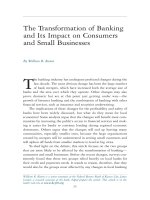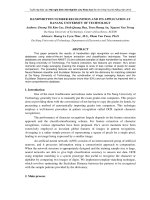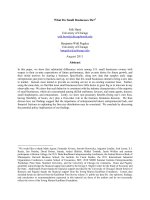What Do Small Businesses Do? Erik Hurst University of Chicago pdf
Bạn đang xem bản rút gọn của tài liệu. Xem và tải ngay bản đầy đủ của tài liệu tại đây (333.52 KB, 64 trang )
What Do Small Businesses Do?
1
Erik Hurst
University of Chicago
Benjamin Wild Pugsley
University of Chicago
August 2011
Abstract
In this paper, we show that substantial differences exists among U.S. small businesses owners with
respect to their ex-ante expectations of future performance, their ex-ante desire for future growth, and
their initial motives for starting a business. Specifically, using new data that samples early stage
entrepreneurs just prior to business start up, we show that few small businesses intend to bring a new idea
to market. Instead, most intend to provide an existing service to an existing customer base. Further,
using the same data, we find that most small businesses have little desire to grow big or to innovate in any
observable way. We show that such behavior is consistent with the industry characteristics of the majority
of small businesses, which are concentrated among skilled craftsmen, lawyers, real estate agents, doctors,
small shopkeepers, and restaurateurs. Lastly, we show non pecuniary benefits (being one’s own boss,
having flexibility of hours, etc.) play a first-order role in the business formation decision. We then
discuss how our findings suggest that the importance of entrepreneurial talent, entrepreneurial luck, and
financial frictions in explaining the firm size distribution may be overstated. We conclude by discussing
the potential policy implications of our findings.
1
We would like to thank Mark Aguiar, Fernando Alvarez, Jaroslav Borovicka, Augustin Landier, Josh Lerner, E.J.
Reedy, Jim Poterba, David Romer, Sarada, Andrei Shleifer, Mihkel Tombak, Justin Wolfers and seminar
participants at Boston College, the 2011 Duke/Kauffman Entrepreneurship Conference, the Federal Reserve Bank of
Minneapolis, Harvard Business School, the Institute for Fiscal Studies, the 2011 International Industrial
Organization Conference, London School of Economics, MIT, 2010 NBER Summer Institute Entrepreneurship
Workshop, Penn State, Stanford University, and the University of Chicago for comments. Hurst and Pugsley
gratefully acknowledge the financial support provided by the George J. Stigler Center for the Study of Economy and
the State. Additionally Hurst thanks the financial support provided by the University of Chicago's Booth School of
Business and Pugsley thanks the financial support from the Ewing Marion Kauffman Foundation. Certain data
included herein are derived from the Kauffman Firm Survey release 3.1 public-use data file. Any opinions, findings,
and conclusions or recommendations expressed in this material are those of the authors and do not necessarily
reflect the views of the Ewing Marion Kauffman Foundation.
1
1. Introduction
Economists and policy makers alike have long been interested in the effects of various economic
policies on business ownership.
2
In fact, the U.S. Small Business Administration is a federally
funded agency whose sole purpose is to help Americans “start, build, and grow businesses.”
Researchers and policy makers often either explicitly or implicitly equate small business owners
with “entrepreneurs.” While this association could be tautological, we show the typical small
business owner is often very different than the entrepreneur that economic models and policy
makers have in mind. For example, economic theory usually considers entrepreneurs as
individuals who (1) innovate and render aging technologies obsolete (Schumpeter, 1942), (2)
take economic risks (Knight (1921); Kihlstrom and Laffont (1979); Kanbur (1979), and
Jovanovic (1979)), or (3) are considered jacks-of-all-trades in the sense that they have a broad
skill set (Lazear, 2005). Policy makers often consider entrepreneurs to be job creators or the
engines of economic growth.
In this paper we shed light on what the vast majority of small businesses actually do and,
further, what they report ex-ante wanting to do. The paper proceeds in six parts. We begin by
highlighting the industrial breakdown of small business within the US. When referring to small
businesses, we primarily refer to firms with between 1 and 19 employees. However, throughout
our analysis, we also define alternative classifications such as firms with between 1 and 100
employees.
3
As we show in this section, over two-thirds of all small businesses are confined to
2
For example, recent academic work has evaluated the implications of various tax regimes on business formation
See Cullen and Gordon (2007) and Cagetti and De Nardi (2009). Just recently, policy makers advocating legislation
to overhaul the U.S. health care system in part justified the reform as promoting entrepreneurial activity and
economic growth by “reducing the [health care] burden on small firms and their workers.” (U.S. Council of
Economic Advisers Report (2009))
3
Within the U.S., twenty percent and thirty five percent of the private sector workforce works in businesses with
between one and twenty employees and between one and one-hundred employees, respectively. In section 2, we
also discuss the importance of non-employers.
2
just 40 narrow 4-digit NAICS industries. All of these industries are ones where participants
provide a relatively standardized good or service to an existing customer base. Specifically,
these industries primarily include skilled craftsmen (e.g., plumbers, electricians, contractors,
painters), skilled professionals (e.g., lawyers, accountants, and architects), insurance and real
estate agents, doctors, dentists, mechanics, beauticians, restaurateurs, and small shop keepers
(e.g., gas station owners and grocery store owners). This composition of small businesses
foreshadows our subsequent empirical results.
In Section 3 of the paper, we study job creation and innovation at small and/or new firms.
First, using a variety of data sets, we show that most surviving small businesses do not grow by
any significant margin. Most firms start small and stay small throughout their entire lifecycle.
4
Also, most surviving small firms do not innovate along any observable margin. We show that
very few small firms report spending resources on research and development, getting a patent, or
even copywriting or trade marking something related to the business (including the company’s
name). Furthermore, we show that nearly half of all new businesses report providing an existing
good or service to an existing market. This is not surprising in light of the most common small
businesses. A new plumber or a new lawyer who opens up a practice often does so in an area
where existing plumbers and existing lawyers already operate.
Most of the existing research attributes differences across firms with respect to ex-post
performance to either differences in financing constraints facing the firms (e.g., Evans and
Jovanovic (1989) and Clementi and Hopenhayn (2006)), differences in ex-post productivity
draws across the firms (e.g., Bonini and Simon (1958), Jovanovic (1982), Pakes and Ericson
4
Haltiwanger et al. (2010) show that controlling for firm age there is no systematic relationship between firm size
and growth. They conclude that the small firms that tend to grow fast (relative to large firms) are those newly
established small firms. We discuss how our results add to these findings in later sections. In particular, we show
that most surviving new firms also do not grow in any meaningful way.
3
(1989), Hopenhayn (1992)), or differences in entrepreneurial ability of the firms owners (e.g.,
Lucas (1978)). In Section 4, we use new data which samples nascent small business owners
about their expectations for the business in the future to show that these stories are incomplete.
When asked at the time of their business formation, most business owners report having no
desire to grow big and no desire to innovate along observable dimensions. In other words, when
starting their business, the plumber and lawyer do so while expecting to remain small well into
the foreseeable future and with little expectation to innovate by developing a new product or
service or even enter new markets with an existing product or service.
If most small businesses do not want to grow or do not want to innovate, why do they
start? We address this question in Section 5. Again, we use a new data set that samples nascent
business owners at the time they were starting their business that specifically asks about motives
and expectations. We find that over 50 percent of new businesses reported that non pecuniary
benefits were the primary reason as to why they started their business. Non pecuniary benefits
included answers such as “wanting flexibility over schedule” or “to be one’s own boss”. By
comparison, only 34 percent of respondents reported that they were starting the business to
generate income and only 40 percent indicated that they were starting a business because they
wanted to create a new product or because they had a good business idea.
5
Using the panel
nature of the data, we show that those small businesses that started for other than innovative
reasons were much less likely to subsequently grow, were much less likely to report wanting to
grow, were much less likely to subsequently innovate, and were much less likely to report
wanting to innovate.
5
The sum of the percentages exceed one hundred percent because respondents could provide up to two reasons why
they started their business. We discuss this data, the nature of the question, and other reported motivations in
subsequent sections.
4
Collectively, these results suggest that there are other first order reasons why small
businesses form aside from the innovation or growth motives which are embedded in most
theories of entrepreneurship. For example, non pecuniary benefits of small business ownership
may be an important driver of why firms start and remain small.
6
Additionally, some industries
may have a natural size of production at an establishment level that is quite low (e.g., insurance
agent).
7
In Section 6 of the paper, we discuss how our results challenge much of the existing
work on entrepreneurship and small firm dynamics. In particular, we highlight how our findings
suggest that the importance of entrepreneurial talent, entrepreneurial luck, and financial frictions
in explaining the firm size distribution may be overstated. In the last section of the paper, we
discuss the policy implications of our results.
The work discussing the diversity of motives and expectations among small businesses in
developing economies is more extensive than for developed economies.
8
Recent work by La
Porta and Shleifer (2008) and Banerjee and Duflo (2011) show that most small businesses in
developing economies do not grow or innovate in any observable way. In the latter sections, we
also discuss how the qualitatively similar outcomes we observe are driven by different forces
than in developing economies.
Overall, our results show that there is substantial skewness among small businesses
within the U.S both in actual and expected growth and innovation behavior. Most small
6
The existence of non-pecuniary benefits as being important for small businesses has been suggested by Hamilton
(2000) and Moskowitz and Vissing-Jorgensen (2002). Both papers find there is a compensating differential for
small business ownership. We discuss these papers in greater depth in section 6.
7
Furthermore, there may be interactions between these two motives in that those who receive large non-pecuniary
benefits from small business ownership may gravitate towards industries where the natural scale of production is
quite low. See Pugsley and Hurst (2011) for a formalization of this claim.
8
Two notable exceptions include Bhide (2000) and Ardagna and Lusardi (2008). Bhide (2000) examines the
attributes of the founders of many successful firms and concludes that the actions and behaviors of the founders are
an important determinant of firm growth. Ardagna and Lusardi (2008) use survey data from the Global
Entrepreneurship Monitor (GEM) to show that there are demographic differences between those individuals who
report starting a business because they had a good business opportunity or other business owners.
5
businesses do not want to grow or innovate which are the usual cornerstones of most of these
entrepreneurial models and policy justifications. Our results suggest that it is often inappropriate
for researchers and policy makers to use the universe of small business (or self employment) data
to test standard theories of entrepreneurship. Researchers and policy makers interested in testing
theories of entrepreneurship may need to use more specialized data sets like the ones that track
small businesses seeking venture capital funding because these firms have been shown to be
more likely to actually grow or innovate relative to other small businesses.
9
Additionally, policy
makers wanting to promote growth and innovation may want to consider more targeted policies
as opposed to creating policies that target the universe of small businesses.
2. Industrial Composition of Small Businesses
The goal of this section is to show that most small businesses are concentrated in a small number
of 4-digit NAICS industries that mostly provide standard services to local customers. This
context is important when interpreting our findings that the majority of small businesses do not
intend to grow or innovate in any substantive way.
To examine the types of small businesses that exist within the U.S., we use data from the
Statistics of U.S. Businesses (SUSB) compiled by the U.S. Census Bureau.
10
To create these
statistics the Census compiles data extracted from the Business Register, which contains the
Census Bureau’s most current and consistent data for U.S. business establishments.
11
The data
9
Some papers in the literature take this approach. See, for example, recent work by Kaplan and Lerner (2009),
Puri and Zarutskie (2010), and Hall and Woodward (2010). As shown by Puri and Zarutskie (2010), firms who seek
venture capital funding are much more likely to grow than the universe of remaining firms.
10
For a complete description of the data, see
11
The Business Register is updated continuously and incorporates data from the Census Bureau’s economic
censuses and current business surveys, quarterly and annual Federal tax records, and other departmental and federal
statistics. The data includes information from all NAICS industries aside from crop and animal production; rail
transportation; National Postal Service; pensions, welfare, and vacation funds; trusts, estates, and agency accounts;
private households; and public administration.
6
cover most U.S. firms with at least one paid employee. Below, we discuss how our results
would extend if we included information from the non-employer firms. We focus our attention
on the statistics from the years 2003 to 2007, all of which are coded using the NAICS 2002
industry definitions; additional data from the Economic Census are also available for 2007.
However, it should be noted that our results are nearly identical if we pick any year between
1998 and 2008. Throughout the paper we classify business size by total firm employment in
order to exclude large firms operating many small establishments.
12
For most purposes in this
section, we refer to "small businesses" as those businesses with between 1 and 20 employees,
although we consider alternative definitions based on different employment size cutoffs.
As is already well known, small businesses are a very large fraction of the population of
employer firms. In Figure 1, we use the SUSB data from 2007 to construct the cumulative
distribution function for firm size using several measures of economic activity. In 2007, there
were roughly 6 million firms with paid employment; 90 percent of these firms had fewer than 20
employees.
13
These firms comprised 20 percent of aggregate paid employment and about 15
percent of sales receipts and payroll.
14
The conclusions only change slightly if we look at firms
with fewer than 100 employees. The additional firms with between 20 and 99 employees
represent an additional 8 percent of all employer firms and 15 percent of aggregate employment.
Next we study the concentration of small businesses with paid employees at very fine
levels of industry classifications. These results yield two important messages. First, most small
12
A firm may consist of many establishments, which are distinct locations of business activity. For example, the
Starbucks corporation operates thousands of small establishments. Given our focus on total firm employment, we
do not treat the individual Starbucks establishments as small businesses.
13
There are an enormous number of non-employer firms (zero paid employees). In 2007, for example, there were an
additional 21.7 million zero employee firms. Often, these are second businesses or independent consultants who
report self employment income on their Federal income tax returns, although they are an important source of future
paid employee firms. See Davis, et al. (2007) for a more detailed discussion.
14
Again, these numbers are likely biased downward to the extent that the three percent of employment that takes
place in non-employer firms are omitted from our analysis.
7
businesses are concentrated in a few detailed industry classifications. Second, within these few
detailed industries, the distribution of employment across all firm sizes is different than the
overall distribution for all other industries. Most of the industries in which small businesses
reside are also industries where most of the economic activity takes place in small firms.
We start by taking the universe of all employer firms with fewer than 20 employees.
Within these small firms, we rank the represented 4-digit industries by a crude measure of
concentration, namely each industry’s share out of the set of small firms.
15
Specifically, we
define:
j
j
j
j
s
x
s
where s
j
is the number of small businesses in industry j and x
j
is the share of small businesses in
industry j out of all small businesses (regardless of industries). This measure gives the
importance of a given industry out of the universe of all small businesses with fewer than 20
employees. There are 294 four-digit NAICS industries in the SUSB data; industries are ranked
from 1 to 294, with the industry with the largest x
j
being ranked 1.
Figure 2 shows the cumulative sum of x
j
across each of the 4-digit industries by rank.
For example, the first twenty 4-digit industries account for just about 50 percent of all firms with
fewer than 20 employees. In other words, when talking about small businesses, roughly half of
them fall into only 20 narrowly defined 4-digit industries. The top 40 4-digit industries
comprise two-thirds of all firms with fewer than 20 employees. The employment shares for the
15
The national SUSB data are available at the 6-digit level of aggregation. Without much loss of generality, we
aggregate these data to a 4-digit level of aggregation.
8
top 20 industries and the top 40 industries (out of all employment in firms with fewer than 20
employees) were also nearly 50 percent and 65 percent, respectively.
Table 1 lists those top forty 4-digit industries ranked by x
j
. Again, two-thirds of all small
businesses in 2007 are in one of these forty 4-digit industries. As seen from the list, most small
business are either restaurants (full service, limited service, or bars), skilled professionals
(doctors, dentists, lawyers, accountants, architects, consultants), skilled craftsmen (general
contractors, plumbers, electricians, mason workers, painters, roofers), professional service
provides (clergy, insurance agents, real estate agents, and travel agents), general service
providers (auto repair, building services such as landscaping, barbers/beauticians), or small
retailers (grocery stores, gas stations, pharmacies, and clothing stores).
These results are robust to alternative cuts of the data. If we extended our classification
to the top sixty 4-digit industries (which comprise over 80 percent of all firms with fewer than 20
employees), the type of industries in which small businesses reside are not altered. The firms
ranked 41 to 60 are similar in spirit to those in the top 40. For example, they include dry
cleaners, office supply stores, hardware stores, jewelry stores, auto dealers, liquor stores,
furniture stores, and the like. Additionally, if we extend our results to those firms with fewer
than 100 employees, our results are very similar. The 40 industries listed in Table 1 also
represent 66 percent of the firms and 61 percent of the employment in firms with fewer than 100
employees.
One question that may arise with the results in Figure 2 and Table 1 is that the industries
that comprise the bulk of small business may just be larger industries (with both more firms and
more employment). In this case, it would not be surprising that these industries comprised a
disproportionate amount of the small businesses given that they comprise a disproportionate
9
amount of all businesses. To see if this concern is driving the results shown in Figure 2 and
Table 1, we define a normalized measure x
j
which accounts for size differences across industries
with respect to the number of firms. Specifically, we define the adjusted measure of small firm
propensity by industry,
j
x
, as being the residual estimated from the following regression:
01
j
j
j
j
j
n
x
n
where x
j
is defined as above and n
j
is the number of firms (irrespective of size) in industry j.
This measure assesses whether the share of small firms from a given industry out of all small
firms is higher or lower than the overall share of firms from the industry (regardless of size) out
of all firms (regardless of size).
Table 2 is analogous to Table 1 except for the fact that we now rank industries based
upon
j
x
instead of x
j
. From comparing Table 1 with Table 2, one can see that it makes little
difference overall whether or not we account for the size of the industry when interpreting what
industries are important for small businesses. Twenty of the top forty industries defined using the
adjusted measure show up on the unadjusted top 40 list in Table 1 (including 15 of the top 20).
For example, restaurants, which represent a disproportionate share of both small and larger firms,
are adjusted down. Yet, if we expanded the tables to include the top 60 or 80 industries by the
different rank measures, the overlap would be much closer to one hundred percent.
The second fact we wish to highlight is that bulk of small businesses are concentrated in
industries where most of the employment is concentrated in small firms. As shown above,
regardless as to whether or not we control for the size of the industry, most small businesses are
skilled craftsmen, doctors, lawyers, real estate agents, and small shopkeepers. For example,
10
looking within the skilled craftsmen industries, 48 percent of all employment (on average) is in
firms with between 1 and 20 employees. Notices, this figure is much larger than the 20 percent
of employment that is in firms with between 1 and 20 employees for the entire economy (as
shown in Figure 1).
To better document the relationship between the importance of an industry within small
businesses and the amount of activity that takes place within small firms within that that
industry, we present Figure 3. The x-axis of Figure 3 are deciles based upon
j
x
, the unadjusted
number of small firms within a given industry out of all small firms in the economy. As in
Figure 2 and Tables 1 and 2, we define small firms as those firms with between 1-19 employees.
However, the patterns we show are broadly consistent if we define small firms to have between 1
and 99 employees. The y-axis of Figure 3 is the within industry share of employment in small
firms relative to all employment in the industry averaged across the industries in the decile.
Formally, we define the within industry share of employment in small firms as:
s
j
j
n
j
e
y
e
where
s
j
e
is the number of employees in small businesses within industry j and
n
j
e
is the number
of employees in all businesses (regardless of size) within industry j. The figure is drawn using
data from 2007 and, as in Tables 1 and 2 and Figures 1 and 2, we define industries using 4-digit
NAICS codes.
The results of Figure 3 show that industries that comprise the bulk of small businesses
(i.e., they have a high x
j
) are also industries where most employment within the industry is in
small firms (have a high y
j
). The top decile of industries with respect to x
j
is comprised of the
first 29 industries documented in Table 1. These industries comprise about 60 percent of the
11
number of small businesses and the employment within small businesses. For these industries,
about 40 percent of employment within the industry, on average, is in small firms. As seen from
Figure 1, only about 20 percent of employment across all industries is in small firms. The high
j
x
industries are skewed toward small firms. As
j
x
falls and the industries become less
important as a fraction of all small businesses, the scale of these industries, for the most part,
monotonically increases.
A few other comments can be made about Figure 3. First, the top three deciles of x
j
contain roughly 90 4-digit industries that comprise roughly 85 percent of all small businesses.
Even the industries in the second and third deciles have within industry employment (y
j
) that is
skewed toward small firms. Second, the difference between the average y
j
for the industries
within the first decile is statistically different from the average y
j
for the industries within all
other deciles. For example, the p-value of the difference between the first and the second deciles
is 0.017 and the p-value of the difference between the first and fourth deciles is < 0.001.
Likewise, the p-value of the difference between the average y
i
for the second and third deciles
relative to the fourth decile is about 0.03. This figure suggests that it may not be surprising that
most small firms do not grow nor report wanting to grow given that most small firms are in
industries where the observed scale of production is quite low.
Before proceeding, we wish to note that most of our analysis in this section focuses on
employer firms. Employer firms are those firms with at least one paid employee. Most firms
within the U.S., however, are non-employer firms. In 2007, for example, there were 21.7 million
zero employee firms which represented roughly 78% of all firms. Often, these are second
businesses or independent consultants who report self employment income on their Federal
income tax returns. As a result, despite their importance in the number of firms, the non-
12
employers collectively represent less than 4 percent of all sales or receipts within the U.S. during
a given year.
16
Because many of the existing datasets, exclude the non-employers from their
analysis, it is hard to systematically analyze their composition. Recently, however, the U.S.
Census has released data that segments the non-employer firms both in numbers and receipts by
broad industry classifications.
17
We summarize this data for 2007 in Appendix Table A1. The
patterns documented in Tables 1 and 2 seem to carry through to non-employers. Most non-
employer firms are in a handful of industries where the bulk of production takes place in small
firms. As a result, we feel our broad results extend to the inclusion of the non-employer firms.
The major take away from this section is that most small businesses are from a limited set
of narrowly defined industries where most of the industries’ economic activity takes place in
small firms. As we discuss in later sections of the paper, these industries usually do not match
the theoretical models of "entrepreneurship" that is usually put forth in the literature.
3. Ex-Post Small Business Growth and Innovation
A. Small Business Growth
It is well documented that there is heterogeneity in the extent to which small businesses grow
across observable factors such as firm size or firm age. Most recently, Haltiwanger et al. (2010)
find, for example, that there is little relationship between firm size and firm growth conditional
on firm age. Employment growth is driven by young firms, who also happen to be small. In
this section, we use some new and existing data sets to illustrate some additional facts about the
distribution of growth propensities across both small and young firms. Specifically, we show
that even among young firms and conditional on survival, growth is still rare overall.
16
Even though they are currently small, the non-employers are an important source of future paid employee firms.
Many eventual employer firms start outs and non-employers. See Davis et al. (2007) for a more detailed discussion.
17
See
13
Tables 3a and 3b show data from the 2005 Business Dynamic Statistics (BDS). The BDS
is produced by the U.S. Census Bureau from longitudinal annual establishment-level
administrative data similar to the source data for the SUSB discussed above. The BDS provides
measures of gross job creation and destruction by firm size and age for the years 1977 through
2009. Sector level measures are available for the US, and overall measures are available by state.
Again, like the SUSB, the database only tracks the employment patterns of employer firms.
Table 3a shows the percent of businesses within different firm age categories that are businesses
with fewer than 20 employees. We do this for the entire economy (top row) and then separately
within different one digit sectors.
18
Table 3a should be read as follows. In 2005, of all operating firms within the economy
that have survived fewer than ten years, 92 percent have fewer than 20 employees (column 1).
Within the construction sector (column 1, fourth row), 93.6 percent of operating “young” firms
have fewer than 20 employees. Table 3b shows the share of employment in firms with fewer
than 20 employees as opposed to the share of firms. The employment share exhibits similar
patterns: for example, firms with fewer than 20 employees have 44.8 percent of the total
employment for all firms who have been in existence for fewer than ten years.
Tables 3a and 3b highlight two important facts. First, among mature firms (firms in
existence between ten and twenty-five years), most firms and much of the employment is in
firms with fewer than twenty employees. For example, across the economy as whole, small firms
represent nearly 90 percent of all firms and nearly 25 percent of all employment out of all firms
that have been in existence between ten and twenty-five years. Even well into their lifecycle, the
overwhelming majority of firms remain small.
18
One digit categories are the finest level of disaggregation available in the public use files.
14
Second, similar to the results in the previous section, there is substantial variation among
industries. Relative to construction, very little of employment of mature firms is in small
businesses within the manufacturing industry (16 percent). Additional industries that include a
high concentration of the employment of mature firms being in small businesses include the
FIRE, wholesale trade, retail trade and service industries. Again, this is consistent with the
results from Tables 1 and 2 and Figure 3. The heterogeneity in the firm size distribution across
sectors implies differences in dynamics by sector.
To shed light on employment dynamics for firms of different ages and industries, we use
data from a variety of additional sources. We start by using data from the 2003 Survey of Small
Business Finances (SSBF).
19
The SSBF is a random sample of businesses with fewer than 500
employees and was conducted by the Board of Governors of the U.S. Federal Reserve. The
survey is designed to measure the financial position of these businesses. However, the survey
also contains other background questions. In 2003, firms were asked to state whether in the past
year the total employees within their business grew, remained the same, or contracted. Firms
were also asked the same question over a three-year horizon.
The responses to these questions by small firms are shown in Table 4. Like above, we
define small firms as those firms with fewer than 20 employees. We break down the responses
by firm age to try to highlight differences between newer businesses and more established
businesses. The SSBF asks businesses to report how long the business has been in existence. As
seen from the table, the overwhelming majority of small firms do not grow by adding employees
19
The SSBF was formerly known as the National Survey of Small Business Finances. It was a quinquennial survey
that began in 1983 and was last conducted in 2003.
15
year to year or even over three-year periods.
20
Not conditioning on firm age, only 14 percent of
surviving small businesses added an employee between 2002 and 2003 and only 21 percent
added employees between 2000 and 2003. Taking the converse, roughly 80 percent of surviving
small firms did not grow at all over a relatively long three year period. The percentages are
slightly higher among newer firms. However, even among small firms which have been in
existence between 1 and 10 years, only 19 percent grew between 2002 and 2003 and only 28
percent grew between 2000 and 2003. These data show that while most aggregate employment
growth may come from small (new) firms growing big, the vast majority of small (new) firms do
not grow, even over longer horizons.
The SSBF data does show that while most firms do not grow at all over multiple years,
some firms did grow. The SSBF data does not tell us by how much they grew. To assess this
question, we turn to the Kauffman Firm Survey (KFS). The KFS is a panel study of 4,928
businesses that were newly founded in 2004 administered by the Kauffman Foundation.
21
As
shown in Haltiwanger et al. (2010), it is the new firms that contribute, on average, to job growth.
Yet, as we have just shown, this is rare for the typical small businesses. While much employment
growth is due to new firms, it is not true that most new businesses generate employment growth.
To create the KFS sample, researchers began with a sample frame of nearly 250,000 new
businesses started in 2004 provided by the Dun and Bradstreet database. From this data, the
KFS oversampled businesses in high tech industries and businesses for whom research and
development employment in the primary business industry was high. The final sample admits
20
We exclude newly founded firms that are unable to answer the employment change question because they did not
exist in the base year. The firms responding to the 1 year change question are at least 1 year old, and the firms
responding to the 3 year change question are at least 3 years old.
21
The Kauffman Foundation is an organization whose goals are to study and understand entrepreneurship.
Information about the organization can be found at
16
4,928 firms, which are re-surveyed annually in follow up interviews. Currently, public use data
is available on these firms up through 2009. For the work below, we only focus on those firms
that have survived through 2008. There were 2,617 such firms in the data. When using the KFS
data, we use the survey weights proved which are designed to make the firms in the sample
representative of all new firms in the economy.
Because the KFS is a four year panel, we can assess the growth rate of employment for
new businesses within the KFS over four years. In each wave of the survey, the KFS asks firms
to report the number of their employees. Column I of Table 5 shows that between 2004 and
2008, 41.9 percent of the surviving firms in the KFS reported growing the total number of
employees within their business. In columns 2 and 3 of Table 5, we show the fraction of new
surviving businesses who added more than 5 employees (column 2) and 10 employees (column
3) between 2004 and 2008. While about forty percent of the surviving new firms within the KFS
added employees, very few added more than one or two employees. Specifically, 60 percent of
all new firms in this sample did not add an employee, 90 percent added fewer than 5 employees,
and 97 percent added fewer than 10 employees.
The results from the KFS hold more broadly in the U.S. We find that industries important
for small businesses (i.e, the ones documented in Tables 1) have lower than average job creation
rates. To see this we pool employment change data from the SUSB from the years 2003 to 2006.
These data are released as a companion to the levels reported in the SUSB annual data. Using the
same administrative data, the Census Bureau measures the number of jobs created (either from
expanding or new establishments) or destroyed (either from contracting or exiting
establishments) at the establishment level and aggregates these into annual measures of gross job
17
creation and destruction by industry and firm size.
22
At the 4-digit industry level, we compute for
each size category the gross job creation rate, the gross job birth rate, and the gross job
destruction rate. We split job creation into jobs created at existing establishments (the gross job
creation rate) and jobs created at opening establishment (the gross job birth rate). The job
destruction rate reflects job loss at both contracting or exiting establishments. We follow Davis,
et al. (1996) and define these rates as follows:
,,1
()/2
s
jt
ss
jt jt
Ms
jt
e
g
M
e
where
s
j
t
M
represents a measure of job creation or destruction (either jobs created from
expansion, jobs created from births, or overall jobs destroyed from contracting and exiting
establishments) for small businesses, s, within industry j between period t and
1t
, and
s
j
t
e
is
defined as above to be the number of employees in small businesses within industry j during
period t. Consistent with our earlier definition, we define small businesses to be those firms with
between 1 and 20 employees. Davis, et al. (1996) show that this form of growth rate has a
number of desirable properties: it accommodates entry and exit, and is equivalent to a log
difference up to 2
nd
order.
We use these growth rates to ask whether or not industries that comprise a large fraction
of small businesses can predict the degree of job creation or destruction for small businesses
within that industry, conditional on aggregate industry characteristics. To do this, we estimate
the following:
22
The distinction between firms (referred to as enterprises by the Census Bureau) and establishments is important.
The SUSB data report expansions (contractions) by firm size, by measuring the employment changes at the
establishment level. If the Starbucks Corporation opens 100 new stores in a year and closes 50, the gross job
creation and destruction from the establishment births and deaths (as well as from continuing establishments) would
be attributed to the 2500+ firm size category.
18
01
Ms
jt j j t
s
j
t
gxZ
where
M
s
j
t
g
takes one of three different measures, depending on the regression, representing
either the gross job creation rate, the gross job birth rate, or the gross job destruction rate for
firms of small firms in industry j. These measures are define above. Likewise, as above, x
j
represents the share of small businesses in industry i out of all small business across all
industries. This measure is the same as what was summarized in Figure 2 and Table 1. Z
j
is a
vector of industry level controls and μ
t
is a vector of year dummies. The industry level controls
include industry wide measures of gross job creation rate, the gross job birth rate, and the gross
job destruction rate. The sample for this regression is all 4-digit industries with non-missing
measures of
s
j
t
M
during the 2003-2006 period. This gives us 929 observations for the small
business gross job creation regressions, 666 observations for the small business gross job birth
rate regression, and 656 observations for the small business gross job destruction regression.
The difference is sample sizes is due to more missing data for the measures of births and job
destruction relative to job creation at the 4-digit industry level.
Table 6 reports the estimation results. We estimate each specification first where each
industry is equally weighted and second where each industry is weighted in proportion to its
share of small businesses. The weighted estimation is similar to a grouped data estimator and
would deliver the same point estimates as firm level data if each small firms employment share
within an industry were equal.
23
The results support our earlier claims that the "typical" small
business does not create jobs. The small business share of an industry has little to say about small
business job creation through new small businesses or small business job destruction (columns 4
23
This is a reasonable approximation since all firms have fewer than 20 employees, so there would be very little
variation in the employment share within an industry if this were estimated with the underlying administrative micro
data.
19
and 5 of Table 6). However, it is a powerful predictor of weaker than average small business job
creation for existing firms (columns 1-3 of Table 6). The most common small businesses (those
with a high x
j
shown in Table 1) grow slower than average. These results hold even controlling
for each industry’s overall characteristics (comparing column 1 vs. column 2 of Table 6). One
may be concerned that that the difference between the strong effects for job creation relative to
the no effects found for job births and job destruction could stem from differences in the samples
across the regression. Column 3 of Table 6 shows such concerns are unwarranted. In this
regression, we restrict the job creation regression to only include observations that had non-
missing job births and job destruction. The job creation results are unaltered with this
additional sample restriction.
According the to the weighted results, for each percentage point increase in the share of
small businesses, an industry's small business job creation rate falls by a little less than three-
quarters of a percentage point. To provide greater context, a one-standard deviation increase in
x
j
(1.1 percentage points) reduces the job creation rate by roughly 0.8 percentage points. The
average weighted job creation rate for the sample was 14.6 percent. So, a one-standard
deviation increase in the industry share of small businesses reduces the small business job
creation rate by about 6 percent (0.8 divided by 14.6). When industries are treated equally, a one
standard deviation increase in x
j
reduces the industry small business job creation rate by roughly
8 percent. All the results are robust to alternative specifications of industry controls.
Additionally, similar results hold if we re-estimate the equation with
j
x
replacing x
j
.
It may initially be surprising that so little job creation comes from the industries that most
small business owners are likely to enter. However it is consistent with an understanding of the
important heterogeneity among small businesses. Most small businesses (those highlighted in
20
Tables 1 and 2) start small and stay small throughout the life of their business. Collectively, we
can conclude three things from the results in Tables 3-6. First, there is substantial skewness
across firms in the extent to which they grow over time. While some firms do grow (in terms of
the number of employees) over time, most do not. Only a small portion of small firms add a
more than ten employees over the life of their business. To this end, the bulk of employment in
mature firms is still concentrated in firms with fewer than 20 employees. Second, even among
new or young firms, most firms do not grow by any meaningful amount, even conditional on
survival. Finally, a portion of the heterogeneity in employment growth for small firms is
explained by industry. While many mature businesses in manufacturing are quite large, most
mature businesses in other industries like construction remain quite small. The industries that
tend to remain small are the industries that tend to comprise the bulk of small businesses.
B. Small Business Innovation
In this sub-section, we document that there is also substantial heterogeneity across firms in the
extent to which they successfully innovate along observable measures. Again, while some
authors have shown that a large share of measured innovation (patent applications for example)
is attributed to small businesses, the converse is not true.
24
Most small firms do not seem to
innovate along those observable margins. Before proceeding, we want to stress that it is hard to
measure all aspects of potential small business innovation via the surveys we are analyzing. As
a result, we focus on some broad measures of innovation that are asked of firms within the
surveys.
24
See Acs and Audretsch (1990) and the cites within.
21
We begin by documenting the fact that very few new firms innovate via patent,
trademarks, or copyrights during the first 4 or 5 years of their existence using two data sources.
First, we continue our use of the Kaufman Firm Survey focusing on the same sample as above.
The KFS survey asks respondents to report separately whether they have already applied or are
in the process of applying for any patents, copyrights, or trademarks. We focus on the responses
in 2008 when the firms have been in business for four years already. These results using the
2008 data from the KFS are shown in Table 7. Within the first four years of business, only 2.7
percent of the businesses in the sample had already applied or were in the process of applying for
patents. Copyright and trademark usage is slightly higher but still most firms do not innovate at
least according to these crude observable measures. According to the KFS, nearly 85 percent of
small businesses did not acquire a patent, trademark or copyright during their first four years of
existence.
We augment our analysis using data from the Panel Study of Entrepreneurial Dynamics II
(PSED).
25
The PSED started with a nationally representative sample of 34,000 individuals
during the fall of 2005 and the early winter of 2006. An initial screening survey identified 1,214
"nascent entrepreneurs". To be considered a nascent entrepreneur, individuals had to meet the
following four criteria. First, the individual had to currently consider themselves as involved in
the firm creation process. Second, they had to have engaged in some start up activity in the past
twelve months. Third, they had to expect to own all or part of the new firm. Finally, the
initiative, at the time of the initial screening survey, could not have progressed to the point that it
could have been considered an operating business. The goal was to sample individuals who were
in the process of establishing a new business.
25
There was an early wave of the PSED (PSED I) that was a test run for the bigger PSED II. We do not use the initial data in
our analysis. All data and documentation for the PSED can be found at
22
In the winter of 2006, after the initial screening interview, the 1,214 respondents that had
been initially identified as being in the process of starting a business were surveyed about a wide
variety of the activities associated with their business start up. As part of the first real interview,
respondents were asked detailed questions about their motivation for starting the business, the
current activities undertaken as part of the start up process, the competitive environment in
which the business would take place, and their expectation of desired future business size and
activities. Follow up interviews occurred annually for 4 years so that the data has a panel
dimension. When analyzing the PSED data, we use three samples. The first is a sample of all
1,214 PSED respondents. The second sample is the 602 respondents who actually had positive
revenues during their first interview in 2006. This latter sample distinguishes people who only
said that they were planning to start a business from those who actually followed through and
engaged in some market business activity. The third sample is the 162 respondents who had
positive revenues from the same business venture in 2010, four years after the first interview.
In terms of innovation activity, the PSED asks three different types of questions. First,
the PSED respondents were asked a similar question as the KFS respondents with respect to
patent, trademark, and copyright application. However, instead of being asked about the three
measures separately, they were asked one joint question. As seen from the PSED data in Table
8, only between 5 and 6 percent of the new firms applied for patents, trademarks, and copyrights
during their first few years in existence. By the fifth year of operation, surviving firms appear
similar to those in the KFS with roughly 17 percent having obtained a patent, trademark or
copyright.
Of course patents, copyrights, and trademarks are imperfect measures of innovation.
Many firms can innovate without applying for a patent, and many firms can trademark their
23
company name without doing any real innovation. We focus first on these measures because
they are easily observable in both the KFS and the PSED. The PSED, however, also has
broader measures of innovation. In a separate set of question, businesses were asked directly
whether they have "developed any proprietary technology, processes, or procedures". This is a
slightly broader measure of innovation than patent, trademark and copyright applications in that
it conceivably covers a more fluid set of activities that the business owner could relay about the
innovation in production or business model that is taking place within their business. Yet, only
between 6 and 8 percent of new businesses (depending on the sample) reported than they had
developed any proprietary business practices or technology during their first few years of
business. Even conditional on survival five years later, 80 percent of firms still report not
developing any proprietary technology, process or procedure.
26
The PSED asks one last broad question about the potential innovation taking place within
the firm. This question asks about how the product or service produced by the businesses
compares with the products and services of other producers within the market. Specifically,
PSED respondents were asked: “Right now, are there many, few, or no other businesses offering
the same products or services to your [intended] customers?” Respondents were allowed to
provide one of the following answers: many, few, or no other. This question is informative in
the sense that it states whether the firm is providing a new product or service to existing
customers or an existing product or service to potentially new customers. Across the three
samples, between 36 and 43 percent of new business owners report providing a similar service to
26
We should be wary of putting too much emphasis on self reports of innovative behavior by small businesses.
However, most behavior stories of how the business owners would respond to such questions would likely lead us to
believe that the innovation numbers are upper bounds on actual behavior. This would occur if the respondents were
more likely to report that they were innovative even if there was no actual innovation taking place within the
business.
24
an existing customer base as existing firms in the market. These businesses, more often than
not, provide a standardized service (e.g., plumbing) to existing local customers. Conversely,
Table 8 also shows that fewer than 20 percent of respondents reported that no one other business
was provided their expected product or service to their expected customer base.
There was substantial variation in the response to this question across business owners in
different industries. For example, owners who reported starting a business in the professional,
health, construction and real estate industries, were between 7.5 and 9.5 percentage points more
likely to report saying that they were staring their business in an area where there were many
current providers of the service to their expected customer base. Owners in these same
industries were nearly 10 percentage points less likely to report that they were providing a new
product or service or were targeting an underserved customer base.
4. Ex-Ante Expectations About Growth and Innovation
In this section, we document that many business owners have no expectation or desire to grow or
innovate when they start their business. One of the strengths of the PSED data is that it asks the
nascent business owners about their expectations for the business, their desired future business
size, and for their motivations for starting the business. For example, all new firms were asked
the following: “Which of the following two statements best describe your preference for the
future size of this new business: ‘I want this new business to be as large as possible’ or ‘I want a
size I can manage myself or with a few key employees’”. The top row of Table 8 shows the
response to this question across our three different PSED samples. For the sample of those
businesses who lasted to 2010, we report their expectations when they were first asked in 2006.
Nearly three quarters of all respondents, regardless of sample, reported they wanted to keep their
business small.









